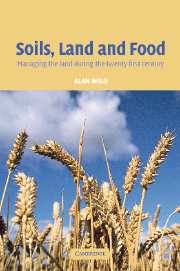Book contents
- Frontmatter
- Contents
- Preface
- Acknowledgements
- 1 Managing land for food production in the twenty-first century: an outline
- 2 Natural resources for sustainable land management
- 3 The development of agriculture and systems of land management
- 4 Maintaining and improving soil fertility
- 5 Land degradation and its control
- 6 Raising yields: use of fertilizers
- 7 Raising yields: water for rainfed crops and irrigation
- 8 Managing change of land use: seven examples
- 9 Increasing and sustaining agricultural production
- 10 Increasing agricultural production: the examples of Africa, India and China
- 11 Prospects and uncertainties
- References
- Index
5 - Land degradation and its control
Published online by Cambridge University Press: 05 June 2012
- Frontmatter
- Contents
- Preface
- Acknowledgements
- 1 Managing land for food production in the twenty-first century: an outline
- 2 Natural resources for sustainable land management
- 3 The development of agriculture and systems of land management
- 4 Maintaining and improving soil fertility
- 5 Land degradation and its control
- 6 Raising yields: use of fertilizers
- 7 Raising yields: water for rainfed crops and irrigation
- 8 Managing change of land use: seven examples
- 9 Increasing and sustaining agricultural production
- 10 Increasing agricultural production: the examples of Africa, India and China
- 11 Prospects and uncertainties
- References
- Index
Summary
INTRODUCTION
Land degradation may be defined as the loss of actual or potential production of biomass and of the capacity to regulate the environment as a result of natural or anthropogenic factors (derived from Lal, 1997).
Loss of productive land adds to the difficulty of feeding an increasing world population and, at the same time, retaining the area of natural or semi-natural ecosystems. The loss may be due to man's activities or to natural causes. An example of loss by natural causes is that during the last 10 000 years a change in climate, particularly to less or no rainfall, has led to the extension of deserts in northern Africa and the Arabian peninsula. Other natural processes include erosion, acidification and salinization of soils, all of which have affected large areas of land. Important as these natural processes are, this chapter deals primarily with degradation caused by man. As will be shown, almost one-sixth of the land area of the world has already been degraded to a greater or lesser extent (although not all by man alone). Techniques for its control and for the recovery of damaged land are economically viable, but are not sufficiently applied.
The effect of degradation may be to lose the whole soil, as occurs in extreme forms of soil erosion, or to result in less capacity to produce biomass in agricultural or natural ecosystems. Environmental consequences follow.
- Type
- Chapter
- Information
- Soils, Land and FoodManaging the Land during the Twenty-First Century, pp. 69 - 92Publisher: Cambridge University PressPrint publication year: 2003



